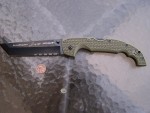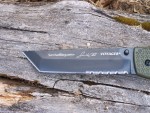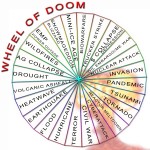This is something I wish I had owned back in my old days at the newspaper. We sometimes had to go places where there was no electricity and coming up with power could be a real hassle. As the years rolled by, the need for power got bigger and bigger. When I started, the cameras were mechanical and we shot film. By the end, everything was digital and required batteries, plus we had computers and cell phones too. We often drove around blowing fuses in cars with inverters plugged into the lighter socket in a desperate effort to keep stuff running. With the Solar Go Kit, I would have had fewer problems and lost much of my fear of electron deprivation. Preppers may well face the same issues that my guys had when working in disaster areas and needed power for their gear.
The Solar Go Kit SGK 440 is a compact, though somewhat heavy, combination of batteries, power analyzer, chargers, inverter, and power connectors that should allow you to keep many of your electrics operational in most any situation. It is packaged in a Pelican 1520 case that measures (in rounded numbers) 20x16x7.5 inches. The case itself comes in at under 1.5 pounds; however, once we stuff all the goodies in, it hits 46 pounds, according to my bathroom scale. The bulk (26 pounds) of the weight comes from the two 22 amp hour 12-volt absorbed glass mat (AGM) batteries that are the heart of the system.
The kit goes for $789.99. The tested unit had some extras–a twin USB outlet and four of the superb Anderson Power Poles. These options add $30 for the USB and $36 for the Power Poles. Note that the inverter has a USB outlet as well as 120 AC, so you could get by without the optional USB port. The Power Poles are widely used in the amateur radio world and are highly reliable and versatile connects for 12-volt loads.
The Go Kit I reviewed came with a rigid 20-watt solar panel that weighs about 4.6 pounds and is 17x17x1 inches in size. Unfortunately, the manufacturer of the panel dropped this size from its offerings and now SolarGoKit is looking for a replacement at a reasonable cost and size. They do offer the PowerFilm R21, which is somewhat unique in that it rolls up and can actually fit inside the Pelican case. This feature makes it costly though at $289.99, but it is hard to beat the compactness. Another option might be one of the folding panels you can find on Amazon. Just be sure to get enough capacity to get current back into the batteries fast enough.
Everything in the kit is solidly constructed. The batteries and some of the components are mounted beneath the panel secured in the bottom half of the Pelican. The AC charger, inverter, power analyzer, and four outlets with Anderson Power Poles are mounted on the panel, accessible when the case is opened. The charger and inverter plug into the Power Poles, and if they are not being used could be disconnected and other equipment plugged into their spots. On the left side of the case is a waterproof plug for a solar panel input, while on the right side is a waterproof 12-volt cigarette lighter-type plug and a waterproof twin USB outlet. The inverter has two AC outlets and an additional USB plug. All in all, this is a lot of versatility in a small package.
I was very impressed with the build quality and choice of components, which I expected as the owner of SolarGoKit.com, Jim Thompson, has a background in aerospace engineering. All of the electrical connections are well made, properly crimped or soldered, then covered with heat shrink wrap to protect them. The external connectors are waterproofed, and the case is a Pelican, which is one of the best carry cases you can get. It is waterproof and so airtight that you get a valve to equalize the pressure to enable you to open it if you change altitudes. There are perforations made in the case for the external connectors, however, and Thompson warns you not to sink it in water; it should, however, stand up to rain and humidity just fine.
The AGM batteries he uses are one of the better things to come along in battery technology. They hit the market in the 70’s and just keep getting better. Their huge advantage over regular batteries is that the acid that reacts with the lead in the battery to make electricity is held in a fiberglass mat so that it can’t leak out of the battery, unlike the one you will probably find in your car. Those batteries are called flooded or wet cell batteries, and they literally have a pool of acid waiting to spill if the case is cracked or tipped. You have to monitor them as they eventually need to have water added to replace that which evaporates. Then there is the fact that they vent hydrogen gas when charged. That’s the stuff that made the airship Hindenburg explode back before WWII.
An AGM battery shouldn’t leak, even if you hold it upside down, and unless charged improperly it vents little gas. While AGM’s should not vent much in the way of hydrogen gas, it is still recommended to charge them in an open area with good air circulation. As long as it is treated right, it won’t lose much if any of the water in the battery that keeps the acid liquid and reacting with the lead. You find AGM’s in uninterruptible power supplies for computers, motorcycles, alarm systems, and most anyplace that needs a battery you can essentially forget about and use in odd positions. They generally have a 5 to 10 year life expectancy. The primary drawback of AGM’s is higher cost.
You get two options for recharging the batteries in the Go Kit. The first is the built-in 1.5 amp charger that runs off 120 volts. The charger was chosen for its compact size so that it would fit in the case, but be advised that you could charge the batteries at a higher rate than 1.5 amps. I spent some time researching AGM’s, and it looks as if the two 22 amp hour batteries in the Go Kit could safely be charged at 10 amps, which would speed things up a bit. If you do decide to use a larger charger, you need to be sure that it, like the built-in one, is designed to handle AGM batteries. It needs to be a smart three-stage charger that begins at a higher voltage, called the bulk charge rate, and then slows down after the battery hits about 80% of capacity. It then switches to the absorption rate and takes it to 85-95% of capacity and finally switches to the float rate to finish it off and maintain it. If your charger simply tries to stuff electricity back in as fast as possible, you run the risk of overheating the battery and shortening its life. Most smart chargers can be left connected to the battery to maintain it at 100% for long term while standard chargers will simply toast your battery. I’ve been there and done that.
Even though you could charge the batteries faster with a bigger, heavier external charger, chances are if you have access to utility power, speed won’t be so critical, so you could get by without a bigger charger. It might be more of a concern if you expect to use a generator.
The specs for the batteries used in the kit say that you will get 200 charge cycles if you use 100% of the charge. Running a battery flat is a really bad idea, so don’t do it. You will get 500 cycles if you drain them 50% and 1,200 if you only pull them down 30%.
One of the very smart features of this kit is the inclusion of the GT Power RC 130A Power Analyzer Battery Consumption Performance Monitor. This lets you keep tabs on the voltage of the batteries as well as how many watts you are using. It can show how many watt hours have been consumed, which will tell you how much of the total capacity of the batteries is left. The unit resets to zero every time you power down, so you have to remember how much power you used in each session between charges. When it hits 250 watts used, you should stop using it and begin charging, unless there are no other options in a crisis.
If you aren’t going to use the kit, you should store it fully charged. That’s true of any battery. It is recommended that you recharge it every six months. You could also keep it on the charger at all times to be sure it is always at 100%, but that might compromise battery life a bit. I’ve seen arguments in both directions about keeping batteries on a maintenance charge, but it makes sense that if you might need a battery unexpectedly you would want to keep it on a maintenance charge even if that is at the cost of some battery life. On the other hand, if you expect to have warning before you need it and are diligent and won’t forget, then the every six months plan seems like a winner and is what Thompson recommends.
Try to store and use anything with batteries in moderate temperatures. They don’t like heat any more than I do. Cooler temperatures slow down the self-discharge rate, which is how fast any battery goes dead just from sitting. However, on the other hand, lower temperatures reduce available capacity. Even though it is contained in the fiberglass mats, there is water in the battery and it seems best to me to not let it freeze. Overall, somewhere around 70 degrees is probably the happiest place for both me and an AGM battery.
The kit gives you three types of power– USB, which is 5 volts; a cigarette light socket; and Anderson Power Pole outlets for 12 volts, plus an inverter that converts the 12 volts into 120 AC. It provides a steady 400 watts of power and can handle brief surges of up to 800 watts. Computing what you can do with the 12 volt and USB outlets is fairly simple. Just find out how many watts your device uses (or its battery holds) and divide that into the number of watts the kit can provide.
The two 12-volt batteries in the kit each provide 22 amp hours of electricity. Work is figured in watts, and watts are amps times volts, so you get 264 watts per battery or 528 watts total. Don’t forget, however, that we don’t want to go below 50% of the battery, so let’s round it off to an easy number like 250 watts. That’s a pretty fair amount of electricity. My tablet computer’s battery takes about 20 watts to fully charge, so this kit could charge it more than 10 times, which would keep me going for a long time.
Figuring out what we can do with the AC power gets more complex as we are dealing with a higher voltage. Because math makes my head hurt, I often use an online calculator to sort out how much runtime I can get from a battery/inverter combination. With this kit, if I were to fully load up the inverter with 400 watts, say four laptop computers or some other combination of devices, I would only get about half an hour of run time. That’s not so great, but it’s still better than not having the tools. If I were more reasonable, I could stretch that out a lot longer.
To be most efficient, however, you should try to avoid using the inverter. The process of making 12 volts DC turn into 120 volts AC uses up energy that is lost in the process. It is sort of like friction. If you can stick with USB and 12 volt equipment, you will get much more run time. I have discovered that many things I have with power adapters can actually run from 12 volts, so skipping the adapter and making a cable with Power Pole connectors can save a lot of energy. If you need to make light, there are a bunch of 12-volt lights on Amazon.
Now that we have an idea about all the great options for getting the juice out of the Go Kit, we have to now consider getting it back in. Every time we take a watt out, we have to put it back and beyond chief issue of finding the power to put in, we also have issues with the time it takes. If you charge them too quickly, batteries won’t last long. That won’t be an issue with the 20 watt solar panel or the 1.5 amp charger that came with the test kit, but they both take a while to replace the used electricity.
Figuring time to recharge is more math work, alas. Since amps times volts equals watts, the AC charger will put about 18 watts back into the batteries in an hour. If we have pulled out 250 watts, then we will need something like 14 hours to get them back in. If we have a bigger charger, like a 10 amp one, then we could charge much faster and get most of the charge back in three hours. One of the problems about batteries, though, is that the last few percent of charge need to be done slowly, so an absolutely full charge can take 10 or more hours even with a bigger charger. The advantage of the bigger charger has to do with being able to quickly get the battery back to 85% or so.
The solar panel gets more complex because of the vagaries of sunlight. Clouds are a colossal pain. The sun also moves around a lot, and if the panel isn’t aimed well it loses efficiency. Then there is the night thing. With the 20-watt panel provided in the test kit, we should be able to recharge our half used batteries in 13 hours, but we don’t get that many hours of sunlight in a day. In fact, according to the solar power industry, most of us only get an average of four to six hours of sunlight a day strong enough to run solar panels at their rated output. A panel may produce power the rest of the day, but it will be at reduced efficiency. Throw in some clouds and rain and you won’t be getting much power at all.
If you were to get a bigger panel, however, you could charge in less time. A 100-watt one should do pretty well, particularly if you can keep it running while using the unit during the day.
One final idea on charging would be to connect it to the cigarette lighter socket in your car. You could plug into the solar input connector or one of the Power Pole plugs inside the case. This isn’t the best way to charge it, but if you are mobile, it would pack some watts back in, taking advantage of some of the gas you are already using.
To use the 120-volts outlets on the inverter or the AC charger, you have to have the case open, which means using it in sheltered location. That’s a good thing as 120 can be dangerous and you don’t want to use it in the rain.
The only thing I can think of changing is that I would have liked to be able to access the fuses from the top panel. They are underneath it; should you blow one, you will need to open the unit up. I would also add some sort of carrying case for the solar panel and, due to back trouble, buy a folding luggage cart for it to ride on.
I’m very impressed with the kit. They offer a similar one with one battery for $40 less, but unless you have an issue with the weight of the kit, I would buy the one with two batteries. Thompson can also customize kits for special purpose, such as running medical gear, and he offers a version for amateur radio operators that puts out the 13.8 volts that a lot of radio gear desires.
– SurvivalBlog Field Gear Editor, Scot Frank Eire





